Apollo 11 astronauts Neil Armstrong and Buzz Aldrin were the first people to walk on the moon. After more than 21 1⁄2 hours on the lunar surface, in addition to the scientific instruments, they left behind an Apollo 1 mission patch (see notes 1) and a memorial bag containing a gold replica of an olive branch as a traditional symbol of peace and a silicon message disk.
The disk carries the goodwill statements by Presidents Eisenhower, Kennedy, Johnson, and Nixon and messages from leaders of 73 countries around the world.
Each message, some handwritten, others typed, was reduced 200 times to a size much smaller than the head of a pin and appears on the disc as a barely visible dot. The disc remains on the lunar surface, protected within an aluminum capsule.
All the messages are reproduced and you can read them on the website forallmoonkind.org.
Message of the President John F. Kennedy:
“We go into space because whatever mankind must undertake, free men must fully share . . . I believe that this Nation should commit itself to
President John F. Kennedy. May 25, 1961.achieving the goal, before this decade is out, of landing a man on the moon and returning him safely to earth. No single space project in this period will be more exciting, or more impressive to mankind, or more important for the long-range exploration of space,and none will be so difficult or expensive to accomplish…”
“For All

Notes
- On January 27, 1967, three NASA astronauts, Roger B. Chaffee (b. February 15, 1935), Virgil I. Grissom (b. April 3, 1926), and Edward H. White II (b. November 14, 1930) died when a flash fire swept through the Apollo 1 command module during a launch rehearsal test.
Sources
- Apollo 11 on Wikipedia
- Space Shuttle Endeavour’s Touchdown Meets Columbia’s Salute [An amazing photo from the past] - February 29, 2024
- Moon Landings: All-Time List [1966-2024] - February 23, 2024
- From Orbit to Ordinary: 10 Earthly Applications of Space Technology - January 23, 2024
